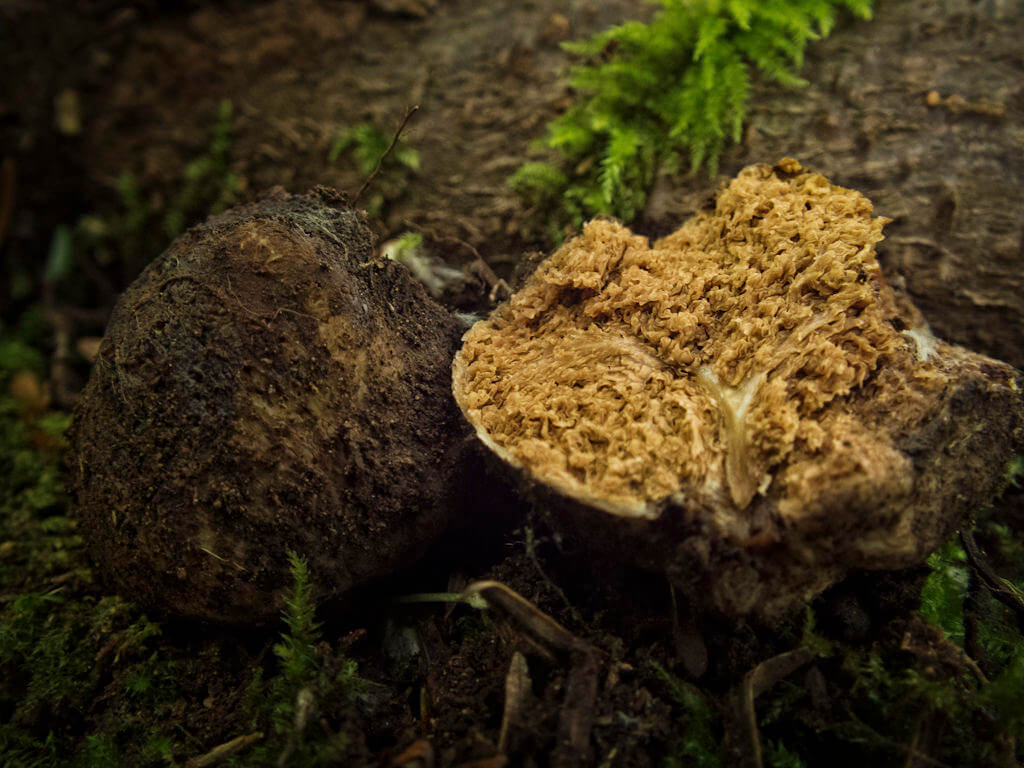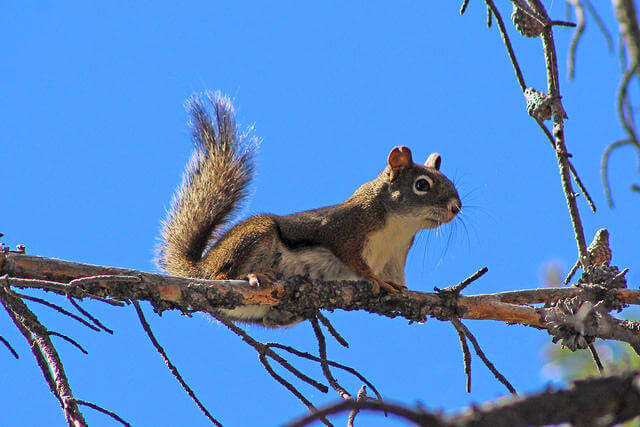Truffles, Trees, and — Squirrels?
by Sue Reel
Broadcast 10.4.2016

Truffle with a squirrel bite. Photo by Flickr user Scott Darbey (CC-BY-2.0).
Listen:
Walking through the woods recently, I saw a red squirrel digging in the litter of the forest floor. I assumed it was burying a pine cone, but on closer inspection I found a piece of mushroom. Little did I know I was witnessing a process critical to the survival of a forest.
Mushrooms are as important to trees as they are to squirrels. In fact, a tree’s survival depends on mushrooms, or mycorrhiza. Mycorrhiza literally means “fungus-root” and denotes a symbiotic relationship between plant roots and certain fungi. A symbiotic relationship is one where two organisms benefit from a close association.
Mycorrhizae form a covering of tissue that grows out from the tiny, non-woody rootlets of trees. Mycorrhizae absorb soil nutrients and transport them to the plant. They also encourage root growth and protect roots from diseases. In turn, the mycorrhizae benefit from the nutrients the tree produces through photosynthesis. This unique and vital relationship was discovered and described as early as 1880, but has only recently been considered in forest management.
Why is it so important? Because the most economically valuable family of trees in the west—Pinacea, which includes pines, hemlocks, Douglas-firs, larches, spruces, and true firs — depend on these tiny fungi. Where do squirrels fit into the picture? Species of mycorrhizae produce two kinds of fruiting bodies—above-ground (what we call mushrooms) and below-ground (known as truffles). Above-ground mushrooms disperse their spores through the air. Although the spores can travel a long distance, many of them fail to find host plants.
The below-ground truffles cannot release their spores into the air and depend on squirrels and other rodents for dispersal. Rodents sniff out the truffles, which have a unique and powerful odor. After they eat them, the spores pass through their digestive system onto the forest floor and without damage. The symbiotic cycle begins again.
In the Pacific Northwest, scientists found that 29 species of forest rodents consumed truffles as part of their diet. Almost 90 percent of the diet of flying squirrels and red-backed voles is truffles, but truffles also nourish chipmunks, pocket gophers, red squirrels, many other small mammals, and even mammals as large as deer and bear. Chipmunks, deer mice, pocket gophers, and other animals that we often think of as forest pests, are really invaluable transporters of nutrients to trees—essential to the survival of a forest.

Squirrel in Beaverhead-Deer Lodge National Forest, Montana
Photo by Flickr user Mark Holloway (CC-BY-2.0).
Every week since 1991, Field Notes has inquired about Montana’s natural history. Field Notes are written by naturalists, students, and listeners about the puzzle-tree bark, eagle talons, woolly aphids, and giant puffballs of Western, Central and Southwestern Montana and aired weekly on Montana Public Radio.
Click here to read and listen to more Field Notes. Field Notes is available as a podcast! Subscribe on iTunes, Google Play, or wherever you listen to podcasts.
Interested in writing a Field Note? Contact Allison De Jong, Field Notes editor, at adejong [at] montananaturalist [dot] org or 406.327.0405.
Want to learn more about our programs as well as fun natural history facts and seasonal phenology? Sign up for our e-newsletter! You can also become a member and get discounts on our programs as well as free reciprocal admission to 300+ science centers in North America!












